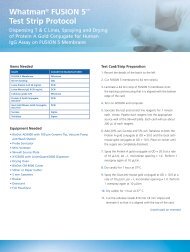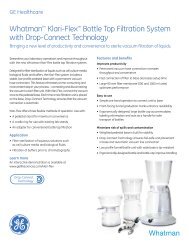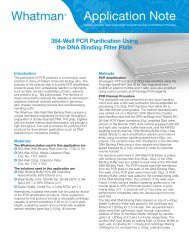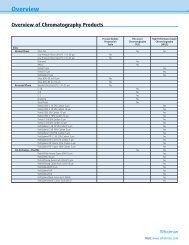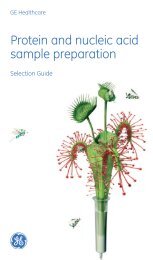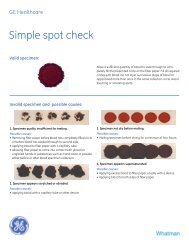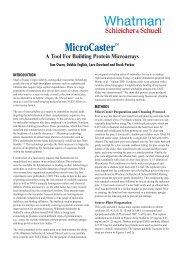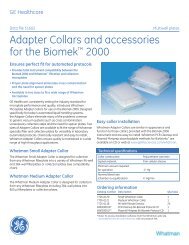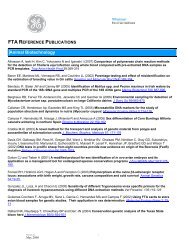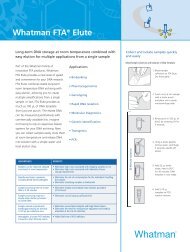Indicating Whatman™ FTA™ Elute Cards
Indicating Whatman™ FTA™ Elute Cards
Indicating Whatman™ FTA™ Elute Cards
Create successful ePaper yourself
Turn your PDF publications into a flip-book with our unique Google optimized e-Paper software.
GE Healthcare<br />
Data file 51716 FTA technology<br />
<strong>Indicating</strong> Whatman FTA <strong>Elute</strong> <strong>Cards</strong><br />
Long-term DNA storage combined with easy<br />
water elution: <strong>Indicating</strong> FTA <strong>Elute</strong> <strong>Cards</strong> provide a<br />
cost effective room temperature method for collecting,<br />
shipping, archiving and processing nucleic<br />
acids from a wide variety of biological samples.<br />
<strong>Indicating</strong> FTA <strong>Elute</strong> <strong>Cards</strong> contain an inert dye<br />
that changes from purple to white indicating the<br />
location of a clear, colorless sample. FTA <strong>Elute</strong><br />
<strong>Cards</strong> facilitate rapid purification of nucleic acids in<br />
less than 30 min per sample. <strong>Indicating</strong> FTA <strong>Elute</strong><br />
provides DNA in solution for multiple amplification<br />
reactions.<br />
<strong>Indicating</strong> FTA <strong>Elute</strong> procedure<br />
• Apply: Sample to <strong>Indicating</strong> FTA <strong>Elute</strong> <strong>Cards</strong> and let dry<br />
completely for 3 h at room temperature or for 15 min at<br />
80ºC.<br />
• Remove: One 3.0 mm disc from the white sample area<br />
on the <strong>Indicating</strong> FTA <strong>Elute</strong> Card and place into a 1.5 ml<br />
microfuge tube.<br />
• Wash: With 500 μl of sterile H 2 O by pulse vortexing 3<br />
times for a total of 5 s.<br />
• Transfer: The disc to a new 0.5 ml microfuge tube<br />
containing 30 μl sterile H O ensuring that the disc is<br />
2<br />
completely submerged.<br />
• Transfer: Tube to a heat block at 95ºC for 15–30 min.<br />
• Remove: The sample from the block and pulse vortex, or<br />
gently tap the sample approximately 60 times.<br />
• Centrifuge: For 30 s, to separate the matrix from the<br />
eluate. The eluate now contains the purified DNA.<br />
• Remove: The FTA <strong>Elute</strong> matrix disc using a sterile pipette<br />
tip and discard.<br />
• Store: The eluted DNA at -20ºC until required<br />
<strong>Indicating</strong> FTA <strong>Elute</strong> <strong>Cards</strong><br />
Fig 1. FTA <strong>Elute</strong> prcedure
Applications<br />
• Biobanking<br />
• Pharmacogenomics<br />
• Genotyping<br />
• Rapid DNA isolation<br />
• Genetic identification<br />
• Microbial identification<br />
• PCR/qPCR<br />
• Whole genome amplification<br />
Comparable PCR amplification from<br />
FTA <strong>Elute</strong> and <strong>Indicating</strong> FTA <strong>Elute</strong><br />
Fig 1. shows the results for PCR amplification<br />
for samples on FTA <strong>Elute</strong> and <strong>Indicating</strong><br />
FTA <strong>Elute</strong>. Blood and buccal cells were<br />
applied to both matrices and DNA recovered<br />
using elution with water and heat. <strong>Elute</strong>d<br />
DNA was amplified for a 268 bp fragment<br />
of the human β-globin gene. PCR amplicons<br />
were analyzed using the Experion Bioanalyzer<br />
(Bio-Rad) according to the manufacturer’s<br />
instructions.<br />
The data show that comparable results are<br />
obtained using both FTA <strong>Elute</strong> and <strong>Indicating</strong><br />
FTA <strong>Elute</strong> for the sample types tested.<br />
DNA recovered from FTA <strong>Elute</strong> is a<br />
template for long PCR amplicons<br />
In order to determine whether DNA eluted<br />
from FTA <strong>Elute</strong> can serve as a template for<br />
longer PCR fragments an amplification ladder<br />
was prepared. Fragments of increasing<br />
length were amplified and separated using<br />
the Experion BioAnalyzer (Bio-Rad).<br />
Fig 2. shows the amplification pattern of<br />
human buccal cell DNA recovered from <strong>Indicating</strong><br />
FTA <strong>Elute</strong>. PCR primers for fragments<br />
as high as 5 kb were tested for amplification<br />
demonstrating that DNA eluted from <strong>Indicating</strong><br />
FTA <strong>Elute</strong> is able to support long PCR.<br />
Features Benefits<br />
Samples can be collected, shipped and stored at room temperature. • Eliminates high costs associated with shipping samples on ice<br />
Sample processing requires a simple water elution procedure to<br />
isolate DNA.<br />
Sample types<br />
• Buccal cells<br />
• Saliva<br />
• Urine<br />
• Cultured cells<br />
• Bacteria cultures<br />
• Eliminates high costs associated with laboratory freezer storage<br />
requirements<br />
• Eliminates the high cost of using a purification kit<br />
<strong>Indicating</strong> dye for sample location. • Confidence that every punch will contain amplifiable DNA<br />
Sample processing time to isolate DNA is 5–30 min. • Eliminates lengthy multiple step procedures<br />
Sample volume requirements are minimal. • DNA extraction from small amounts of precious samples<br />
PCR inhibitors and proteins are bound to the <strong>Indicating</strong> FTA <strong>Elute</strong><br />
matrix.<br />
• Yields soluble DNA free of PCR inhibitors<br />
Blood<br />
MW Markers FTA <strong>Elute</strong> <strong>Indicating</strong> FTA <strong>Elute</strong><br />
Fig 2. Blood and buccal cell samples on FTA <strong>Elute</strong> and <strong>Indicating</strong> FTA <strong>Elute</strong><br />
Fig 3. Amplification ladder of DNA recovered from FTA <strong>Elute</strong><br />
<strong>Indicating</strong> FTA <strong>Elute</strong> <strong>Cards</strong><br />
Buccal Cells<br />
FTA <strong>Elute</strong> <strong>Indicating</strong> FTA <strong>Elute</strong>
100 200 300 400<br />
A DNA from Blood spotted onto FTA <strong>Elute</strong><br />
Fig 4. STR profiles from blood and buccal cell DNA recovered from <strong>Indicating</strong> FTA <strong>Elute</strong> and FTA <strong>Elute</strong><br />
MW<br />
Buccal<br />
Sample 1A<br />
4000<br />
3000<br />
2000<br />
1000<br />
D3S1358<br />
4000<br />
3000<br />
2000<br />
1000<br />
D3S1358<br />
AM<br />
100 200 300 400<br />
AM<br />
2 mm punch (n=11)<br />
ng/μl<br />
vWA<br />
D5S818<br />
D5S818<br />
Fig 5. Analysis of different sample types on <strong>Indicating</strong> FTA <strong>Elute</strong><br />
Total<br />
ngss<br />
Buccal<br />
Sample 1B<br />
3 mm punch (n=3)<br />
ng/μl<br />
Total<br />
ngs<br />
1 0.40 11.85 1 0.41 24.64<br />
2 0.37 11.24 2 0.62 37.10<br />
3 0.55 16.45 3 0.35 20.97<br />
4 0.57 17.08 4 0.90 54.07<br />
5 0.38 11.37 5 0.47 27.95<br />
6 0.54 16.12 6 0.32 19.39<br />
7 0.15 4.59 7 0.55 33.03<br />
8 0.02 0.59 8 0.58 34.55<br />
9 0.44 13.33 9 0.70 42.23<br />
10 0.17 5.12 10 0.41 24.40<br />
Avg. Yield 0.36 10.77 11 0.61 36.39<br />
Table 1. DNA Yield from <strong>Indicating</strong> FTA <strong>Elute</strong><br />
vWA<br />
TH01<br />
D21S11<br />
D13S317<br />
D21S11<br />
TH01<br />
D13S317<br />
D8S1179<br />
D8S1179<br />
D16S539<br />
D7S820<br />
TP0X<br />
D7S820<br />
TP0X<br />
D18S51<br />
CSF1P0<br />
D16S539<br />
CSF1P0<br />
D18S51<br />
FGA<br />
FGA<br />
Penta E<br />
Penta E<br />
Penta D<br />
Penta D<br />
12 0.91 54.44<br />
Avg. Yield 0.57 34.10<br />
B<br />
6000<br />
5000<br />
4000<br />
3000<br />
2000<br />
1000<br />
6000<br />
5000<br />
4000<br />
3000<br />
2000<br />
1000<br />
100 200 300 400<br />
DNA from Buccal Cells spotted onto FTA <strong>Elute</strong><br />
AM D3S1358<br />
D5S818<br />
vWA<br />
D13S317<br />
TH01<br />
D8S1179<br />
D21S11<br />
TP0X<br />
D7S820<br />
D16S539<br />
100 200 300 400<br />
AM<br />
D16S539 D18S51<br />
DNA from Buccal Cells spotted onto <strong>Indicating</strong> FTA <strong>Elute</strong><br />
D3S1358<br />
D5S818<br />
vWA<br />
TH01<br />
STR Analysis<br />
A main application of the DNA purified from a human sample<br />
using FTA <strong>Elute</strong> is for human identification through the use of<br />
Short Tandem Repeats or STRs. STRs are short DNA fragments amplified<br />
from genomic DNA which discriminate individuals apart on a<br />
genetic basis. Blood (Fig 3. A) and buccal cells (Fig 3. B) were taken<br />
from a single individual and applied to both FTA <strong>Elute</strong> and <strong>Indicating</strong><br />
FTA <strong>Elute</strong> to compare the STR pattern from DNA on both matrices.<br />
The amplification reaction consists of a multiplex PCR of 13–16 fragments.<br />
In Fig 3, 1 ng of input DNA from FTA <strong>Elute</strong> and <strong>Indicating</strong> FTA<br />
<strong>Elute</strong> was amplified using a Promega PowerPlex 16 system and<br />
fragments analyzed using an ABI Prism 310 Genetic Analyzer.<br />
PCR amplification of DNA from various sample types<br />
A variety of sample types which are clear or colorless were applied<br />
to <strong>Indicating</strong> FTA <strong>Elute</strong> (Fig 4.). The color change from purple to white<br />
indicates the location of the sample.<br />
Lanes 1–4 represent a 91 bp β-lactamase gene fragment amplified<br />
from plasmid DNA in bacteria Top 10 or DH5α cells. Lanes 5–10<br />
represent human cell samples which were amplified for the 268 bp<br />
β-globin gene. Dilute samples such as urine gave a strong amplified<br />
signal.<br />
DNA yield from <strong>Indicating</strong> FTA <strong>Elute</strong><br />
The yield of DNA from buccal cells was examined from both 2 mm<br />
(Table 1A) and 3 mm punches from <strong>Indicating</strong> FTA <strong>Elute</strong> (Table 1B).<br />
DNA from single 2 mm punches was eluted in 30 μl and DNA from<br />
pairs of 3 mm punches was eluted in 60 μl water. The DNA yield was<br />
determined by real time PCR using ABI Absolute Quantitation system<br />
RNaseP on an ABI Prism 7900HT. Each data point in the 3 mm punch<br />
column represents an average of 3 punch sets from a single buccal<br />
cell donor, while the 2 mm disc values represent the average of 11<br />
points within a single buccal cell transfer area.<br />
D7S820<br />
CSF1P0<br />
CSF1P0<br />
D18S51<br />
D13S317<br />
D8S1179<br />
D21S11 D16S539<br />
D18S51<br />
FGA<br />
TP0X<br />
FGA<br />
Penta D<br />
Penta E<br />
Penta D<br />
Penta E
1A ngs<br />
6.67<br />
7.59<br />
2A<br />
3A<br />
4A<br />
6.48<br />
5.00 5.61 8.84 3.84 2.98<br />
2.69<br />
5.10 1.49<br />
ngs<br />
28.59 36.48<br />
12.15<br />
Fig 6. DNA distribution across buccal<br />
samples<br />
Allele Y (Allele 2)<br />
Allele Y (Allele 2)<br />
3.72 28.04 6.95 14.98 4.14<br />
23.27 9.78<br />
9.25<br />
ngs<br />
2.19<br />
6.69<br />
16.45<br />
3.56 32.36 33.09 33.27 4.91<br />
29.82<br />
22.93 2.57<br />
ngs<br />
2.07 11.63<br />
11.67<br />
0.28 23.08 20.13 15.26 1.10<br />
13.67 16.88 7.89<br />
6.0<br />
5.0<br />
4.0<br />
3.0<br />
2.0<br />
1.0<br />
0.0<br />
CYP2c9*2<br />
www.gelifesciences.com/whatman<br />
1B<br />
2B<br />
3B<br />
4B<br />
-1.3 -0.8 -0.3 0.2 0.7 1.2 1.7 2.2 2.7 3.2<br />
Allele X (Allele 1)<br />
6.0<br />
5.0<br />
4.0<br />
3.0<br />
2.0<br />
1.0<br />
0.0<br />
CYP2c19*2<br />
-1.0 0.0 1.0 2.0 3.0 4.0<br />
Allele X (Allele 1)<br />
Legend<br />
X Undetermined • Both ■ NTC<br />
• Allele X • Allele Y<br />
Fig 7. Allelic Discrimination SNP Analysis<br />
GE Healthcare UK Limited<br />
Amersham Place<br />
Little Chalfont<br />
Buckinghamshire, HP7 9NA<br />
UK<br />
DNA yield distribution<br />
The distribution of cells collected on<br />
<strong>Indicating</strong> FTA <strong>Elute</strong> was measured as<br />
a function of yield using real time PCR.<br />
Buccal cell samples were collected with<br />
Whatman EasiCollect and deposited<br />
onto <strong>Indicating</strong> FTA <strong>Elute</strong> <strong>Cards</strong>. In Fig<br />
5., eleven 2 mm punches were removed<br />
from each buccal sample to create<br />
an area map. Each 2 mm punch was<br />
processed according to the standard<br />
FTA <strong>Elute</strong> protocol with DNA elution<br />
into 30 μl of water. Panels A show the<br />
total DNA recovered from each punch<br />
corresponding to the location in panels<br />
B. There are similar DNA recoveries<br />
between punches but clearly some<br />
punches sample cell clumps containing<br />
higher concentrations of cells.<br />
Allelic discrimination<br />
The plot in Fig 6. shows a typical example<br />
of mutation detection from high<br />
quality DNA eluted from <strong>Indicating</strong> FTA<br />
<strong>Elute</strong> from six related individuals. DNA<br />
was measured using the ABI Absolute<br />
Quantitation system RNaseP and analyzed<br />
using TaqMan Allelic Discrimination<br />
assays (Applied Biosystems). The<br />
DNA from <strong>Indicating</strong> FTA <strong>Elute</strong> <strong>Cards</strong><br />
provided a quality template sufficient<br />
for multiple Allelic Discrimination assays.<br />
The data show that four members<br />
of the family are heterozygous for the<br />
CYP2c9*2 allele 1 and 2 while the other<br />
two members are homozygous for the<br />
allele 1. All six members of the family<br />
are homozygous for the CYP2c19*2<br />
SNP allele 1.<br />
Conclusions<br />
<strong>Indicating</strong> FTA <strong>Elute</strong> contains an inert dye<br />
that changes color upon application of a<br />
clear colorless sample. <strong>Indicating</strong> FTA <strong>Elute</strong><br />
is used for samples such as buccal cells,<br />
urine, saliva and cultured cells. DNA recovered<br />
from <strong>Indicating</strong> FTA <strong>Elute</strong> is of the same<br />
quality as from FTA <strong>Elute</strong>.<br />
Ordering Information<br />
Description<br />
<strong>Indicating</strong> FTA<br />
Quantity<br />
Catalog<br />
number<br />
<strong>Elute</strong> Micro Card<br />
<strong>Indicating</strong> FTA<br />
25 WB120412<br />
<strong>Elute</strong> Micro Card<br />
FTA <strong>Elute</strong> Micro<br />
100 WB120411<br />
Card<br />
FTA <strong>Elute</strong> Micro<br />
25 WB120401<br />
Card 100 WB120410<br />
GE, imagination at work and GE monogram are trademarks<br />
of General Electric Company.<br />
EasiCollect, FTA, and Whatman are trademarks of GE<br />
Healthcare companies.<br />
All third party trademarks are the property of their<br />
respective owners.<br />
© 2007-2010 General Electric Company – All rights<br />
reserved. Previously published December 2007.<br />
All goods and services are sold subject to the terms and<br />
conditions of sale of the company within GE Healthcare<br />
which supplies them. A copy of these terms and<br />
conditions is available on request. Contact your local<br />
GE Healthcare Representative for the most current<br />
information.<br />
GE Healthcare Bio-Sciences AB<br />
Björkgatan 30<br />
751 84 Uppsala<br />
Sweden<br />
GE Healthcare Bio-Sciences Corp.<br />
800 Centennial Avenue<br />
Piscataway, NJ 08855-1327 USA<br />
GE Healthcare Europe, GmbH<br />
Munzinger Strasse, D-79111 Freiburg<br />
Germany<br />
GE Healthcare Japan Corporation<br />
Sanken Bldg., 3-25-1, Hyakunincho<br />
Shinjuku-ku, Tokyo 169-0073<br />
Japan<br />
51716 04/2010






